Exploring Intersectionality in Research Methodology: A Critical Analysis
VerifiedAdded on 2020/01/06
|13
|3878
|162
Report
AI Summary
The provided content appears to be a collection of research methodology resources, including books, journals, and online materials. The topics covered range from general research methodology and qualitative/quantitative approaches to specific methods such as single case research, intersectionality theory, and youth participatory action research. Additionally, there are resources on ethics in research, deductive and inductive reasoning, and research design. Overall, this compilation of resources provides a comprehensive overview of various research methodologies and techniques that can be applied in different fields of study.
Contribute Materials
Your contribution can guide someone’s learning journey. Share your
documents today.
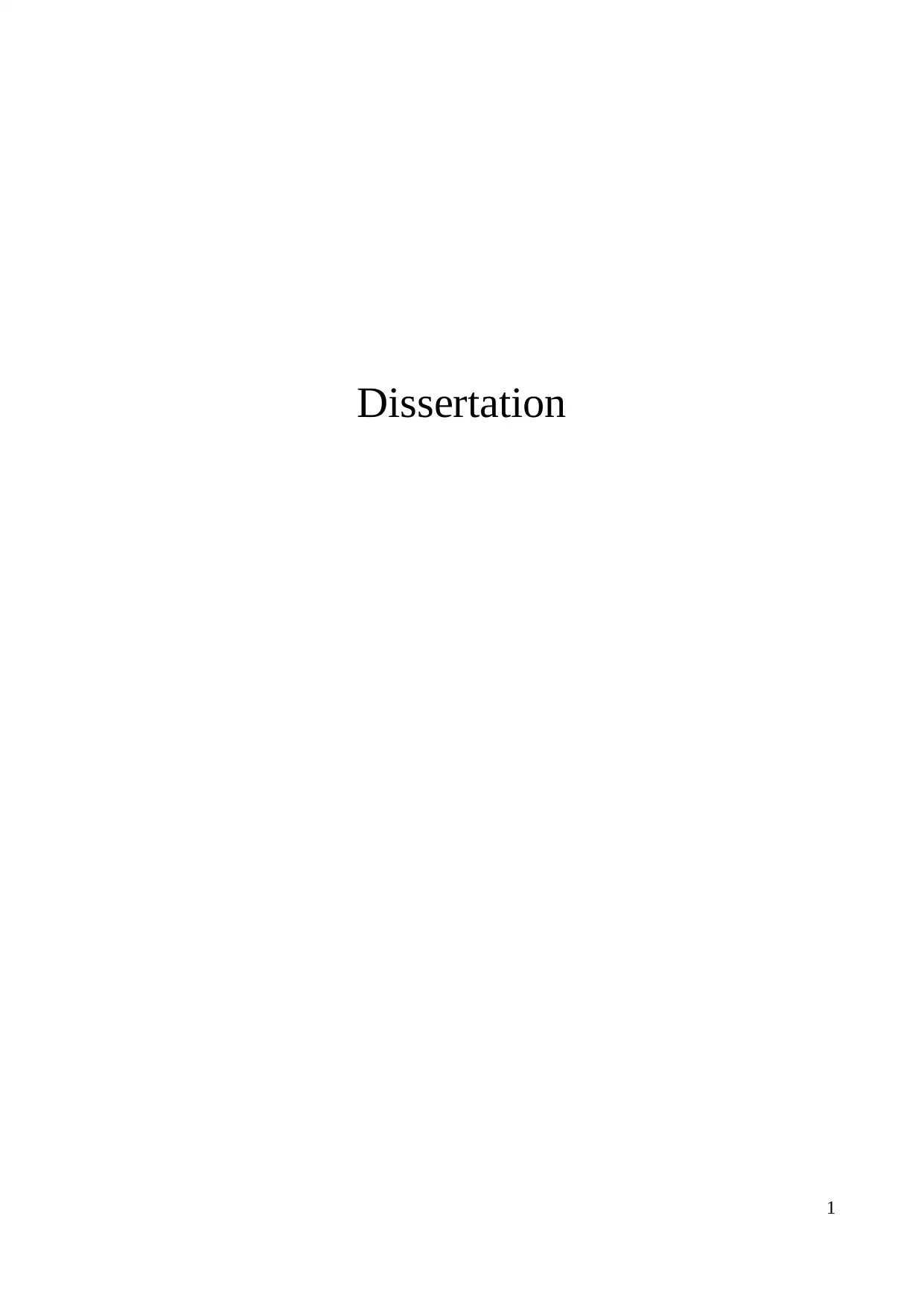
Dissertation
1
1
Secure Best Marks with AI Grader
Need help grading? Try our AI Grader for instant feedback on your assignments.
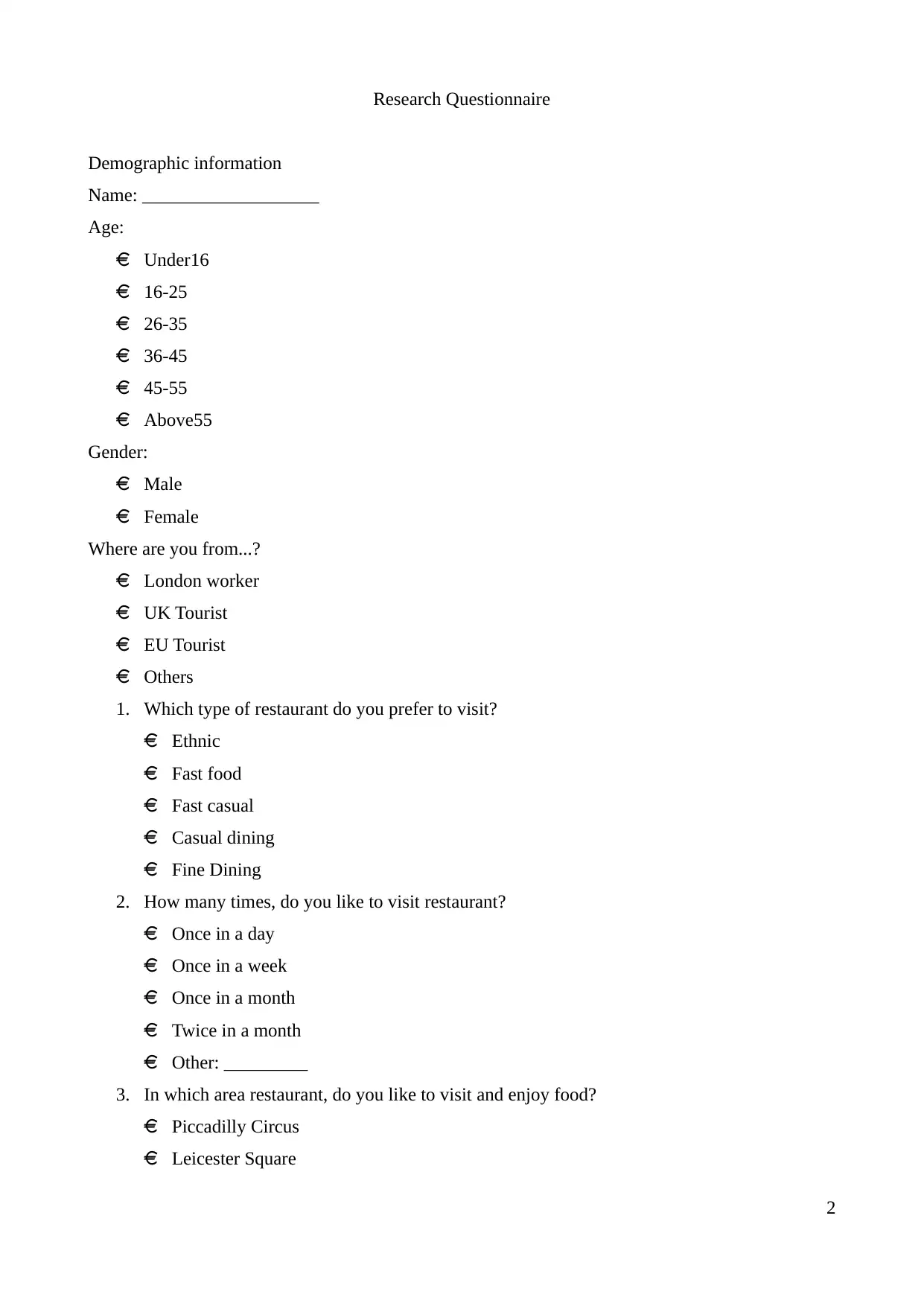
Research Questionnaire
Demographic information
Name: ___________________
Age:
Under16
16-25
26-35
36-45
45-55
Above55
Gender:
Male
Female
Where are you from...?
London worker
UK Tourist
EU Tourist
Others
1. Which type of restaurant do you prefer to visit?
Ethnic
Fast food
Fast casual
Casual dining
Fine Dining
2. How many times, do you like to visit restaurant?
Once in a day
Once in a week
Once in a month
Twice in a month
Other: _________
3. In which area restaurant, do you like to visit and enjoy food?
Piccadilly Circus
Leicester Square
2
Demographic information
Name: ___________________
Age:
Under16
16-25
26-35
36-45
45-55
Above55
Gender:
Male
Female
Where are you from...?
London worker
UK Tourist
EU Tourist
Others
1. Which type of restaurant do you prefer to visit?
Ethnic
Fast food
Fast casual
Casual dining
Fine Dining
2. How many times, do you like to visit restaurant?
Once in a day
Once in a week
Once in a month
Twice in a month
Other: _________
3. In which area restaurant, do you like to visit and enjoy food?
Piccadilly Circus
Leicester Square
2
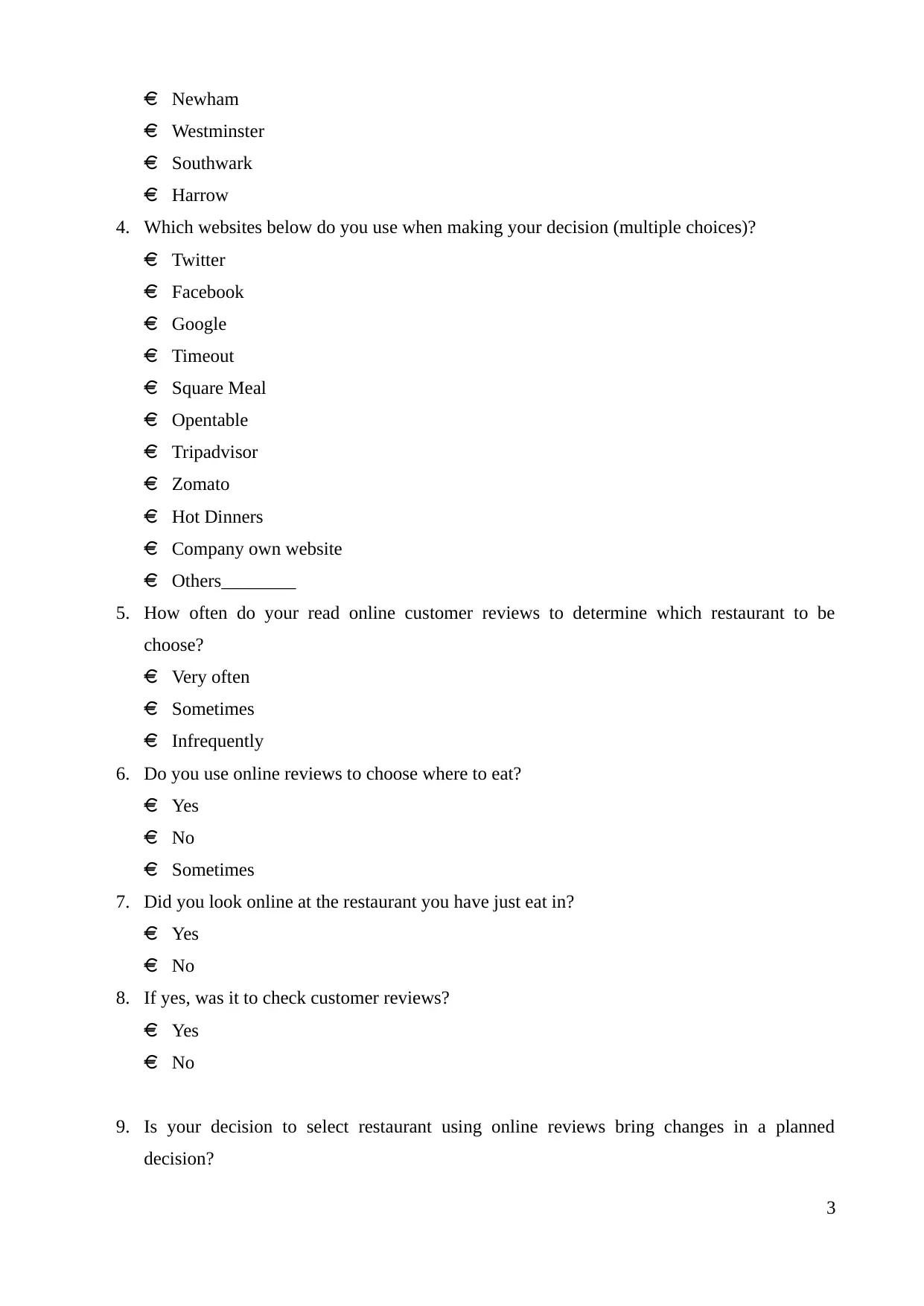
Newham
Westminster
Southwark
Harrow
4. Which websites below do you use when making your decision (multiple choices)?
Twitter
Facebook
Google
Timeout
Square Meal
Opentable
Tripadvisor
Zomato
Hot Dinners
Company own website
Others________
5. How often do your read online customer reviews to determine which restaurant to be
choose?
Very often
Sometimes
Infrequently
6. Do you use online reviews to choose where to eat?
Yes
No
Sometimes
7. Did you look online at the restaurant you have just eat in?
Yes
No
8. If yes, was it to check customer reviews?
Yes
No
9. Is your decision to select restaurant using online reviews bring changes in a planned
decision?
3
Westminster
Southwark
Harrow
4. Which websites below do you use when making your decision (multiple choices)?
Timeout
Square Meal
Opentable
Tripadvisor
Zomato
Hot Dinners
Company own website
Others________
5. How often do your read online customer reviews to determine which restaurant to be
choose?
Very often
Sometimes
Infrequently
6. Do you use online reviews to choose where to eat?
Yes
No
Sometimes
7. Did you look online at the restaurant you have just eat in?
Yes
No
8. If yes, was it to check customer reviews?
Yes
No
9. Is your decision to select restaurant using online reviews bring changes in a planned
decision?
3
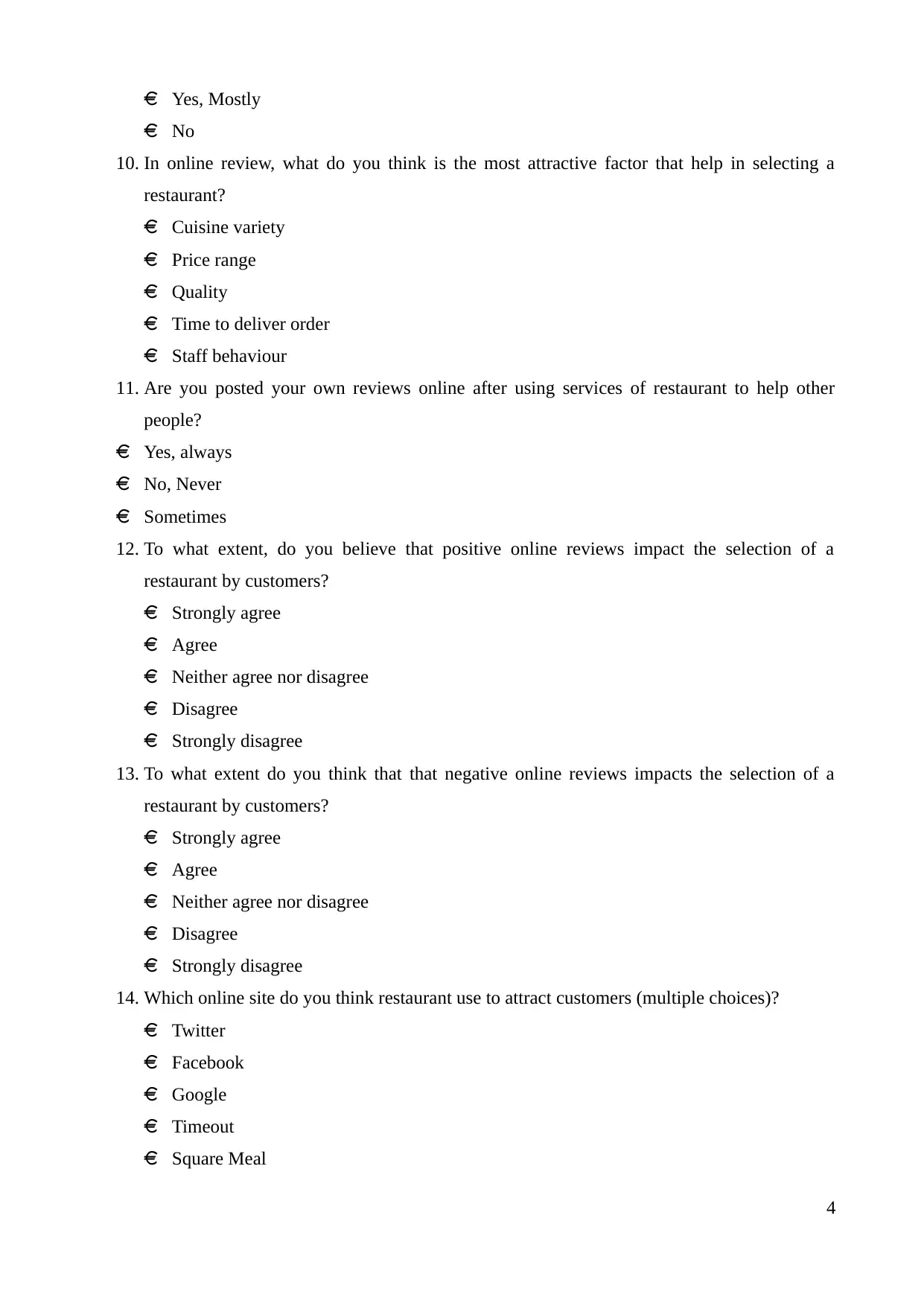
Yes, Mostly
No
10. In online review, what do you think is the most attractive factor that help in selecting a
restaurant?
Cuisine variety
Price range
Quality
Time to deliver order
Staff behaviour
11. Are you posted your own reviews online after using services of restaurant to help other
people?
Yes, always
No, Never
Sometimes
12. To what extent, do you believe that positive online reviews impact the selection of a
restaurant by customers?
Strongly agree
Agree
Neither agree nor disagree
Disagree
Strongly disagree
13. To what extent do you think that that negative online reviews impacts the selection of a
restaurant by customers?
Strongly agree
Agree
Neither agree nor disagree
Disagree
Strongly disagree
14. Which online site do you think restaurant use to attract customers (multiple choices)?
Twitter
Facebook
Google
Timeout
Square Meal
4
No
10. In online review, what do you think is the most attractive factor that help in selecting a
restaurant?
Cuisine variety
Price range
Quality
Time to deliver order
Staff behaviour
11. Are you posted your own reviews online after using services of restaurant to help other
people?
Yes, always
No, Never
Sometimes
12. To what extent, do you believe that positive online reviews impact the selection of a
restaurant by customers?
Strongly agree
Agree
Neither agree nor disagree
Disagree
Strongly disagree
13. To what extent do you think that that negative online reviews impacts the selection of a
restaurant by customers?
Strongly agree
Agree
Neither agree nor disagree
Disagree
Strongly disagree
14. Which online site do you think restaurant use to attract customers (multiple choices)?
Timeout
Square Meal
4
Secure Best Marks with AI Grader
Need help grading? Try our AI Grader for instant feedback on your assignments.
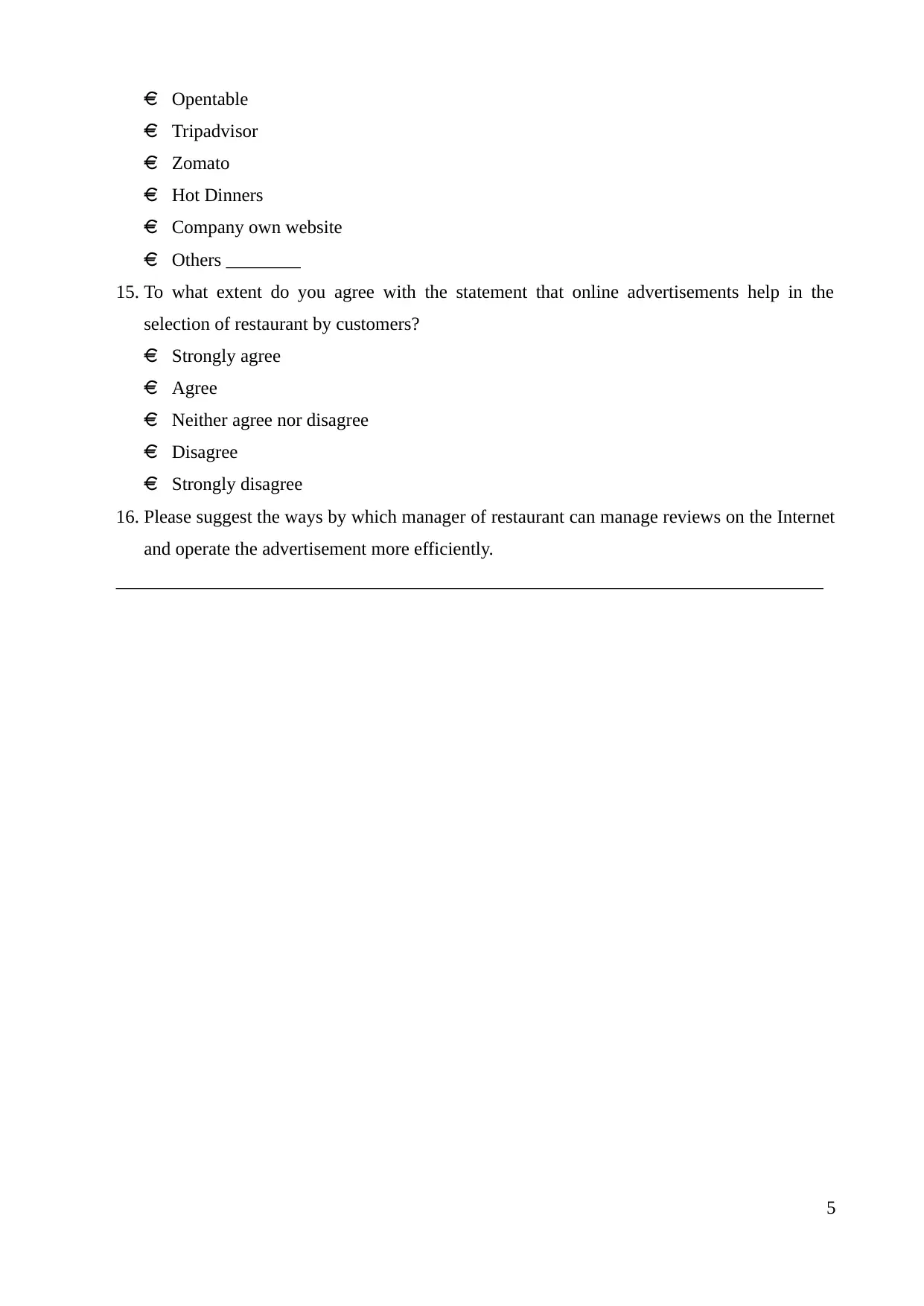
Opentable
Tripadvisor
Zomato
Hot Dinners
Company own website
Others ________
15. To what extent do you agree with the statement that online advertisements help in the
selection of restaurant by customers?
Strongly agree
Agree
Neither agree nor disagree
Disagree
Strongly disagree
16. Please suggest the ways by which manager of restaurant can manage reviews on the Internet
and operate the advertisement more efficiently.
____________________________________________________________________________
5
Tripadvisor
Zomato
Hot Dinners
Company own website
Others ________
15. To what extent do you agree with the statement that online advertisements help in the
selection of restaurant by customers?
Strongly agree
Agree
Neither agree nor disagree
Disagree
Strongly disagree
16. Please suggest the ways by which manager of restaurant can manage reviews on the Internet
and operate the advertisement more efficiently.
____________________________________________________________________________
5
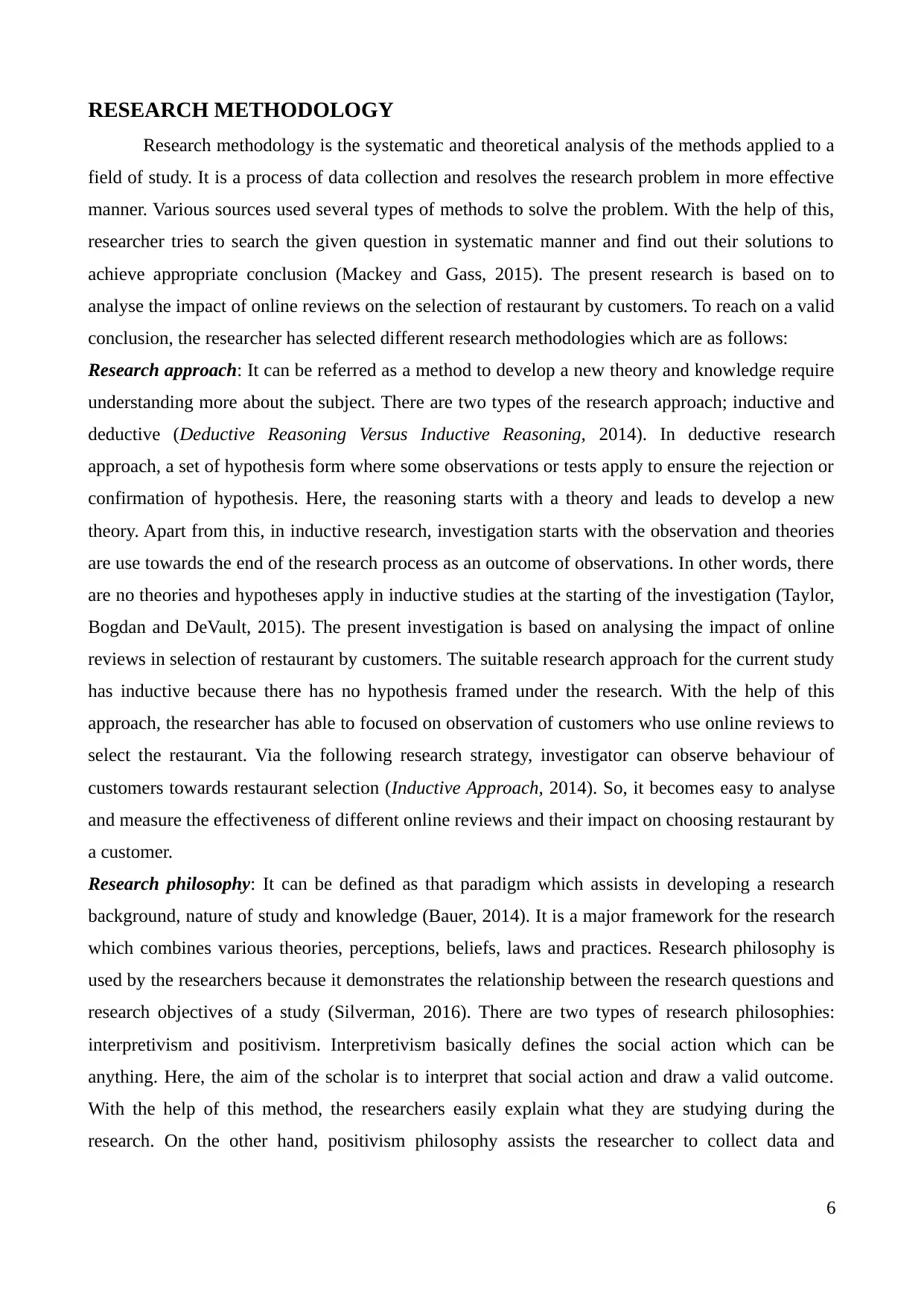
RESEARCH METHODOLOGY
Research methodology is the systematic and theoretical analysis of the methods applied to a
field of study. It is a process of data collection and resolves the research problem in more effective
manner. Various sources used several types of methods to solve the problem. With the help of this,
researcher tries to search the given question in systematic manner and find out their solutions to
achieve appropriate conclusion (Mackey and Gass, 2015). The present research is based on to
analyse the impact of online reviews on the selection of restaurant by customers. To reach on a valid
conclusion, the researcher has selected different research methodologies which are as follows:
Research approach: It can be referred as a method to develop a new theory and knowledge require
understanding more about the subject. There are two types of the research approach; inductive and
deductive (Deductive Reasoning Versus Inductive Reasoning, 2014). In deductive research
approach, a set of hypothesis form where some observations or tests apply to ensure the rejection or
confirmation of hypothesis. Here, the reasoning starts with a theory and leads to develop a new
theory. Apart from this, in inductive research, investigation starts with the observation and theories
are use towards the end of the research process as an outcome of observations. In other words, there
are no theories and hypotheses apply in inductive studies at the starting of the investigation (Taylor,
Bogdan and DeVault, 2015). The present investigation is based on analysing the impact of online
reviews in selection of restaurant by customers. The suitable research approach for the current study
has inductive because there has no hypothesis framed under the research. With the help of this
approach, the researcher has able to focused on observation of customers who use online reviews to
select the restaurant. Via the following research strategy, investigator can observe behaviour of
customers towards restaurant selection (Inductive Approach, 2014). So, it becomes easy to analyse
and measure the effectiveness of different online reviews and their impact on choosing restaurant by
a customer.
Research philosophy: It can be defined as that paradigm which assists in developing a research
background, nature of study and knowledge (Bauer, 2014). It is a major framework for the research
which combines various theories, perceptions, beliefs, laws and practices. Research philosophy is
used by the researchers because it demonstrates the relationship between the research questions and
research objectives of a study (Silverman, 2016). There are two types of research philosophies:
interpretivism and positivism. Interpretivism basically defines the social action which can be
anything. Here, the aim of the scholar is to interpret that social action and draw a valid outcome.
With the help of this method, the researchers easily explain what they are studying during the
research. On the other hand, positivism philosophy assists the researcher to collect data and
6
Research methodology is the systematic and theoretical analysis of the methods applied to a
field of study. It is a process of data collection and resolves the research problem in more effective
manner. Various sources used several types of methods to solve the problem. With the help of this,
researcher tries to search the given question in systematic manner and find out their solutions to
achieve appropriate conclusion (Mackey and Gass, 2015). The present research is based on to
analyse the impact of online reviews on the selection of restaurant by customers. To reach on a valid
conclusion, the researcher has selected different research methodologies which are as follows:
Research approach: It can be referred as a method to develop a new theory and knowledge require
understanding more about the subject. There are two types of the research approach; inductive and
deductive (Deductive Reasoning Versus Inductive Reasoning, 2014). In deductive research
approach, a set of hypothesis form where some observations or tests apply to ensure the rejection or
confirmation of hypothesis. Here, the reasoning starts with a theory and leads to develop a new
theory. Apart from this, in inductive research, investigation starts with the observation and theories
are use towards the end of the research process as an outcome of observations. In other words, there
are no theories and hypotheses apply in inductive studies at the starting of the investigation (Taylor,
Bogdan and DeVault, 2015). The present investigation is based on analysing the impact of online
reviews in selection of restaurant by customers. The suitable research approach for the current study
has inductive because there has no hypothesis framed under the research. With the help of this
approach, the researcher has able to focused on observation of customers who use online reviews to
select the restaurant. Via the following research strategy, investigator can observe behaviour of
customers towards restaurant selection (Inductive Approach, 2014). So, it becomes easy to analyse
and measure the effectiveness of different online reviews and their impact on choosing restaurant by
a customer.
Research philosophy: It can be defined as that paradigm which assists in developing a research
background, nature of study and knowledge (Bauer, 2014). It is a major framework for the research
which combines various theories, perceptions, beliefs, laws and practices. Research philosophy is
used by the researchers because it demonstrates the relationship between the research questions and
research objectives of a study (Silverman, 2016). There are two types of research philosophies:
interpretivism and positivism. Interpretivism basically defines the social action which can be
anything. Here, the aim of the scholar is to interpret that social action and draw a valid outcome.
With the help of this method, the researchers easily explain what they are studying during the
research. On the other hand, positivism philosophy assists the researcher to collect data and
6
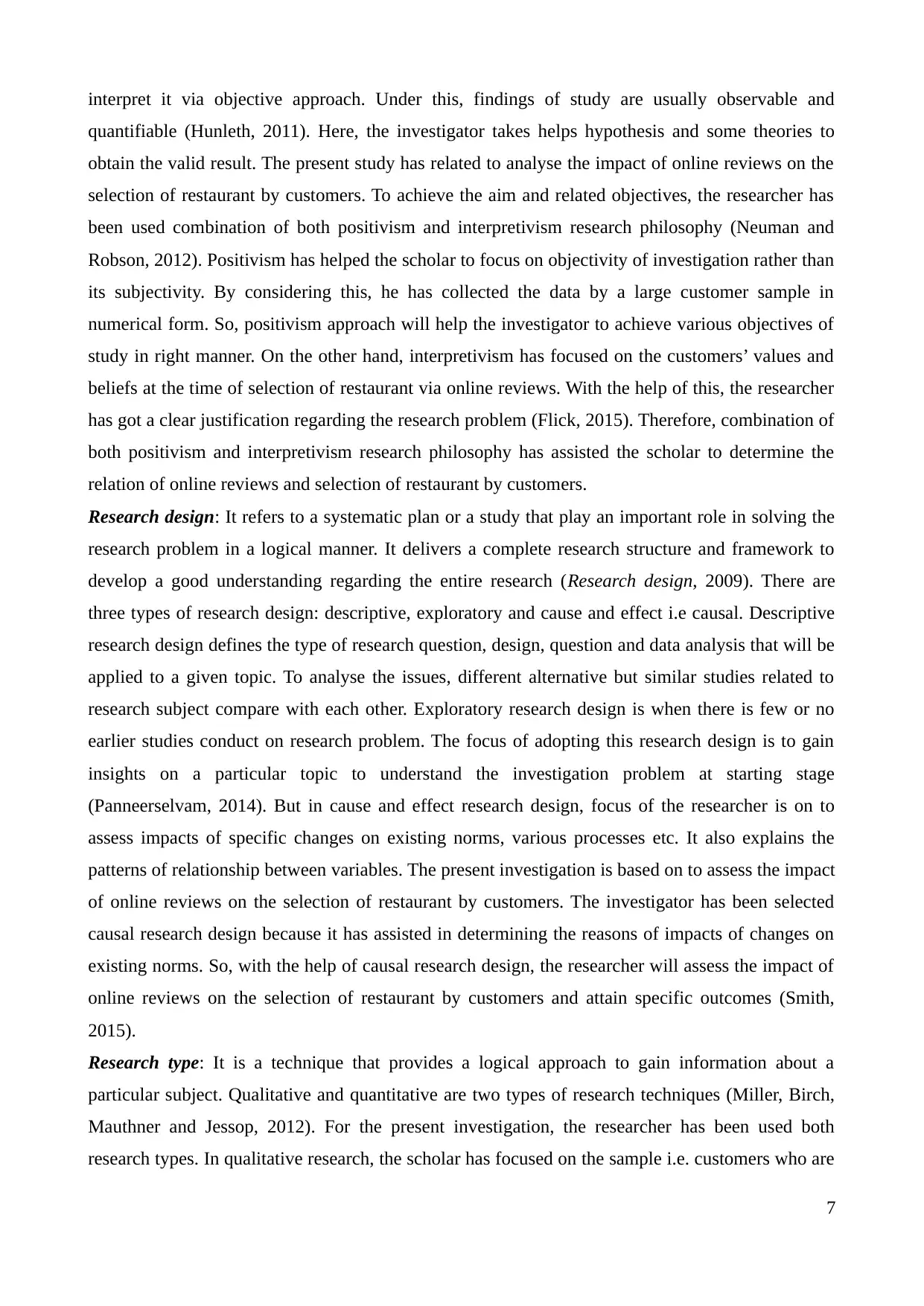
interpret it via objective approach. Under this, findings of study are usually observable and
quantifiable (Hunleth, 2011). Here, the investigator takes helps hypothesis and some theories to
obtain the valid result. The present study has related to analyse the impact of online reviews on the
selection of restaurant by customers. To achieve the aim and related objectives, the researcher has
been used combination of both positivism and interpretivism research philosophy (Neuman and
Robson, 2012). Positivism has helped the scholar to focus on objectivity of investigation rather than
its subjectivity. By considering this, he has collected the data by a large customer sample in
numerical form. So, positivism approach will help the investigator to achieve various objectives of
study in right manner. On the other hand, interpretivism has focused on the customers’ values and
beliefs at the time of selection of restaurant via online reviews. With the help of this, the researcher
has got a clear justification regarding the research problem (Flick, 2015). Therefore, combination of
both positivism and interpretivism research philosophy has assisted the scholar to determine the
relation of online reviews and selection of restaurant by customers.
Research design: It refers to a systematic plan or a study that play an important role in solving the
research problem in a logical manner. It delivers a complete research structure and framework to
develop a good understanding regarding the entire research (Research design, 2009). There are
three types of research design: descriptive, exploratory and cause and effect i.e causal. Descriptive
research design defines the type of research question, design, question and data analysis that will be
applied to a given topic. To analyse the issues, different alternative but similar studies related to
research subject compare with each other. Exploratory research design is when there is few or no
earlier studies conduct on research problem. The focus of adopting this research design is to gain
insights on a particular topic to understand the investigation problem at starting stage
(Panneerselvam, 2014). But in cause and effect research design, focus of the researcher is on to
assess impacts of specific changes on existing norms, various processes etc. It also explains the
patterns of relationship between variables. The present investigation is based on to assess the impact
of online reviews on the selection of restaurant by customers. The investigator has been selected
causal research design because it has assisted in determining the reasons of impacts of changes on
existing norms. So, with the help of causal research design, the researcher will assess the impact of
online reviews on the selection of restaurant by customers and attain specific outcomes (Smith,
2015).
Research type: It is a technique that provides a logical approach to gain information about a
particular subject. Qualitative and quantitative are two types of research techniques (Miller, Birch,
Mauthner and Jessop, 2012). For the present investigation, the researcher has been used both
research types. In qualitative research, the scholar has focused on the sample i.e. customers who are
7
quantifiable (Hunleth, 2011). Here, the investigator takes helps hypothesis and some theories to
obtain the valid result. The present study has related to analyse the impact of online reviews on the
selection of restaurant by customers. To achieve the aim and related objectives, the researcher has
been used combination of both positivism and interpretivism research philosophy (Neuman and
Robson, 2012). Positivism has helped the scholar to focus on objectivity of investigation rather than
its subjectivity. By considering this, he has collected the data by a large customer sample in
numerical form. So, positivism approach will help the investigator to achieve various objectives of
study in right manner. On the other hand, interpretivism has focused on the customers’ values and
beliefs at the time of selection of restaurant via online reviews. With the help of this, the researcher
has got a clear justification regarding the research problem (Flick, 2015). Therefore, combination of
both positivism and interpretivism research philosophy has assisted the scholar to determine the
relation of online reviews and selection of restaurant by customers.
Research design: It refers to a systematic plan or a study that play an important role in solving the
research problem in a logical manner. It delivers a complete research structure and framework to
develop a good understanding regarding the entire research (Research design, 2009). There are
three types of research design: descriptive, exploratory and cause and effect i.e causal. Descriptive
research design defines the type of research question, design, question and data analysis that will be
applied to a given topic. To analyse the issues, different alternative but similar studies related to
research subject compare with each other. Exploratory research design is when there is few or no
earlier studies conduct on research problem. The focus of adopting this research design is to gain
insights on a particular topic to understand the investigation problem at starting stage
(Panneerselvam, 2014). But in cause and effect research design, focus of the researcher is on to
assess impacts of specific changes on existing norms, various processes etc. It also explains the
patterns of relationship between variables. The present investigation is based on to assess the impact
of online reviews on the selection of restaurant by customers. The investigator has been selected
causal research design because it has assisted in determining the reasons of impacts of changes on
existing norms. So, with the help of causal research design, the researcher will assess the impact of
online reviews on the selection of restaurant by customers and attain specific outcomes (Smith,
2015).
Research type: It is a technique that provides a logical approach to gain information about a
particular subject. Qualitative and quantitative are two types of research techniques (Miller, Birch,
Mauthner and Jessop, 2012). For the present investigation, the researcher has been used both
research types. In qualitative research, the scholar has focused on the sample i.e. customers who are
7
Paraphrase This Document
Need a fresh take? Get an instant paraphrase of this document with our AI Paraphraser
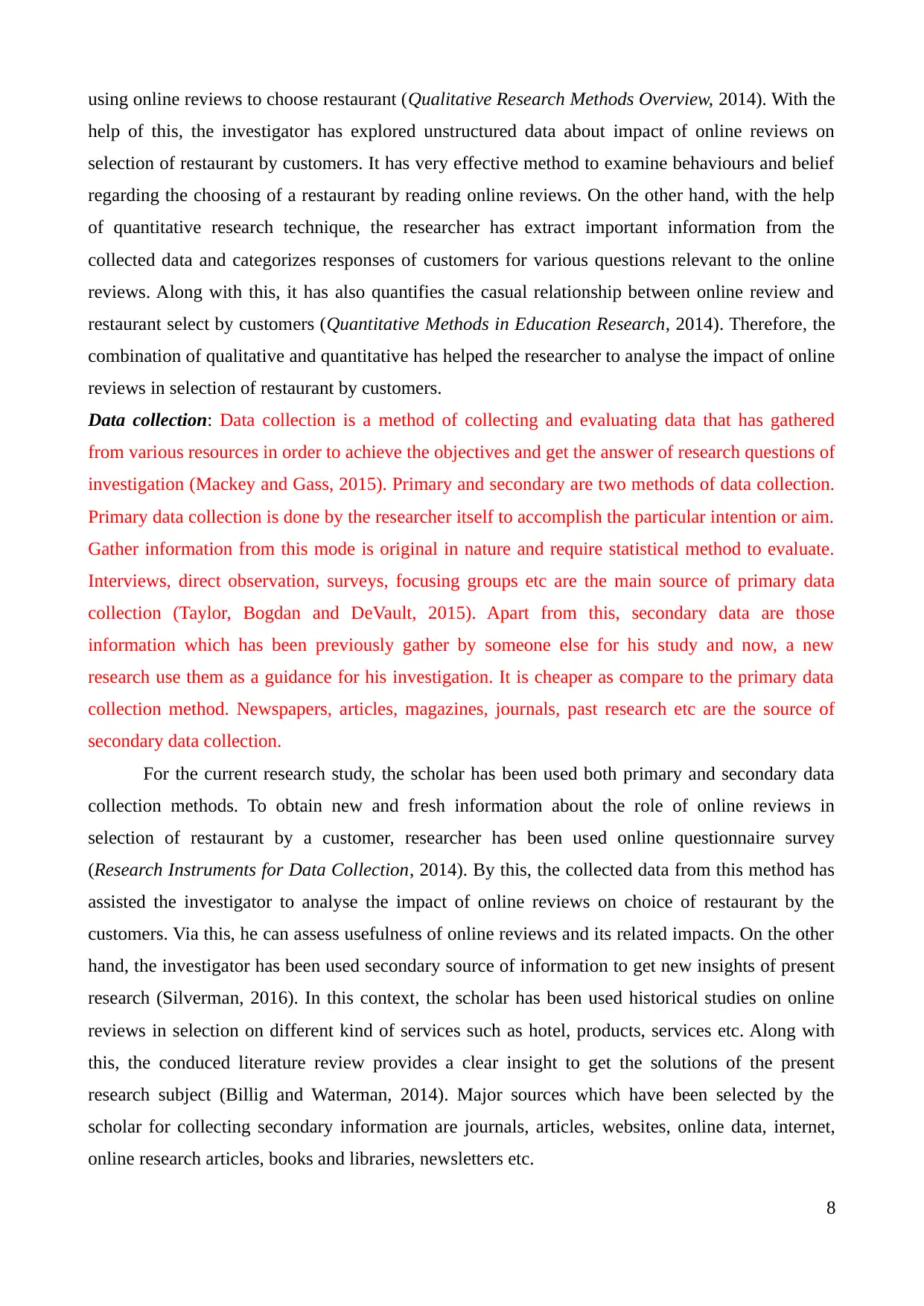
using online reviews to choose restaurant (Qualitative Research Methods Overview, 2014). With the
help of this, the investigator has explored unstructured data about impact of online reviews on
selection of restaurant by customers. It has very effective method to examine behaviours and belief
regarding the choosing of a restaurant by reading online reviews. On the other hand, with the help
of quantitative research technique, the researcher has extract important information from the
collected data and categorizes responses of customers for various questions relevant to the online
reviews. Along with this, it has also quantifies the casual relationship between online review and
restaurant select by customers (Quantitative Methods in Education Research, 2014). Therefore, the
combination of qualitative and quantitative has helped the researcher to analyse the impact of online
reviews in selection of restaurant by customers.
Data collection: Data collection is a method of collecting and evaluating data that has gathered
from various resources in order to achieve the objectives and get the answer of research questions of
investigation (Mackey and Gass, 2015). Primary and secondary are two methods of data collection.
Primary data collection is done by the researcher itself to accomplish the particular intention or aim.
Gather information from this mode is original in nature and require statistical method to evaluate.
Interviews, direct observation, surveys, focusing groups etc are the main source of primary data
collection (Taylor, Bogdan and DeVault, 2015). Apart from this, secondary data are those
information which has been previously gather by someone else for his study and now, a new
research use them as a guidance for his investigation. It is cheaper as compare to the primary data
collection method. Newspapers, articles, magazines, journals, past research etc are the source of
secondary data collection.
For the current research study, the scholar has been used both primary and secondary data
collection methods. To obtain new and fresh information about the role of online reviews in
selection of restaurant by a customer, researcher has been used online questionnaire survey
(Research Instruments for Data Collection, 2014). By this, the collected data from this method has
assisted the investigator to analyse the impact of online reviews on choice of restaurant by the
customers. Via this, he can assess usefulness of online reviews and its related impacts. On the other
hand, the investigator has been used secondary source of information to get new insights of present
research (Silverman, 2016). In this context, the scholar has been used historical studies on online
reviews in selection on different kind of services such as hotel, products, services etc. Along with
this, the conduced literature review provides a clear insight to get the solutions of the present
research subject (Billig and Waterman, 2014). Major sources which have been selected by the
scholar for collecting secondary information are journals, articles, websites, online data, internet,
online research articles, books and libraries, newsletters etc.
8
help of this, the investigator has explored unstructured data about impact of online reviews on
selection of restaurant by customers. It has very effective method to examine behaviours and belief
regarding the choosing of a restaurant by reading online reviews. On the other hand, with the help
of quantitative research technique, the researcher has extract important information from the
collected data and categorizes responses of customers for various questions relevant to the online
reviews. Along with this, it has also quantifies the casual relationship between online review and
restaurant select by customers (Quantitative Methods in Education Research, 2014). Therefore, the
combination of qualitative and quantitative has helped the researcher to analyse the impact of online
reviews in selection of restaurant by customers.
Data collection: Data collection is a method of collecting and evaluating data that has gathered
from various resources in order to achieve the objectives and get the answer of research questions of
investigation (Mackey and Gass, 2015). Primary and secondary are two methods of data collection.
Primary data collection is done by the researcher itself to accomplish the particular intention or aim.
Gather information from this mode is original in nature and require statistical method to evaluate.
Interviews, direct observation, surveys, focusing groups etc are the main source of primary data
collection (Taylor, Bogdan and DeVault, 2015). Apart from this, secondary data are those
information which has been previously gather by someone else for his study and now, a new
research use them as a guidance for his investigation. It is cheaper as compare to the primary data
collection method. Newspapers, articles, magazines, journals, past research etc are the source of
secondary data collection.
For the current research study, the scholar has been used both primary and secondary data
collection methods. To obtain new and fresh information about the role of online reviews in
selection of restaurant by a customer, researcher has been used online questionnaire survey
(Research Instruments for Data Collection, 2014). By this, the collected data from this method has
assisted the investigator to analyse the impact of online reviews on choice of restaurant by the
customers. Via this, he can assess usefulness of online reviews and its related impacts. On the other
hand, the investigator has been used secondary source of information to get new insights of present
research (Silverman, 2016). In this context, the scholar has been used historical studies on online
reviews in selection on different kind of services such as hotel, products, services etc. Along with
this, the conduced literature review provides a clear insight to get the solutions of the present
research subject (Billig and Waterman, 2014). Major sources which have been selected by the
scholar for collecting secondary information are journals, articles, websites, online data, internet,
online research articles, books and libraries, newsletters etc.
8
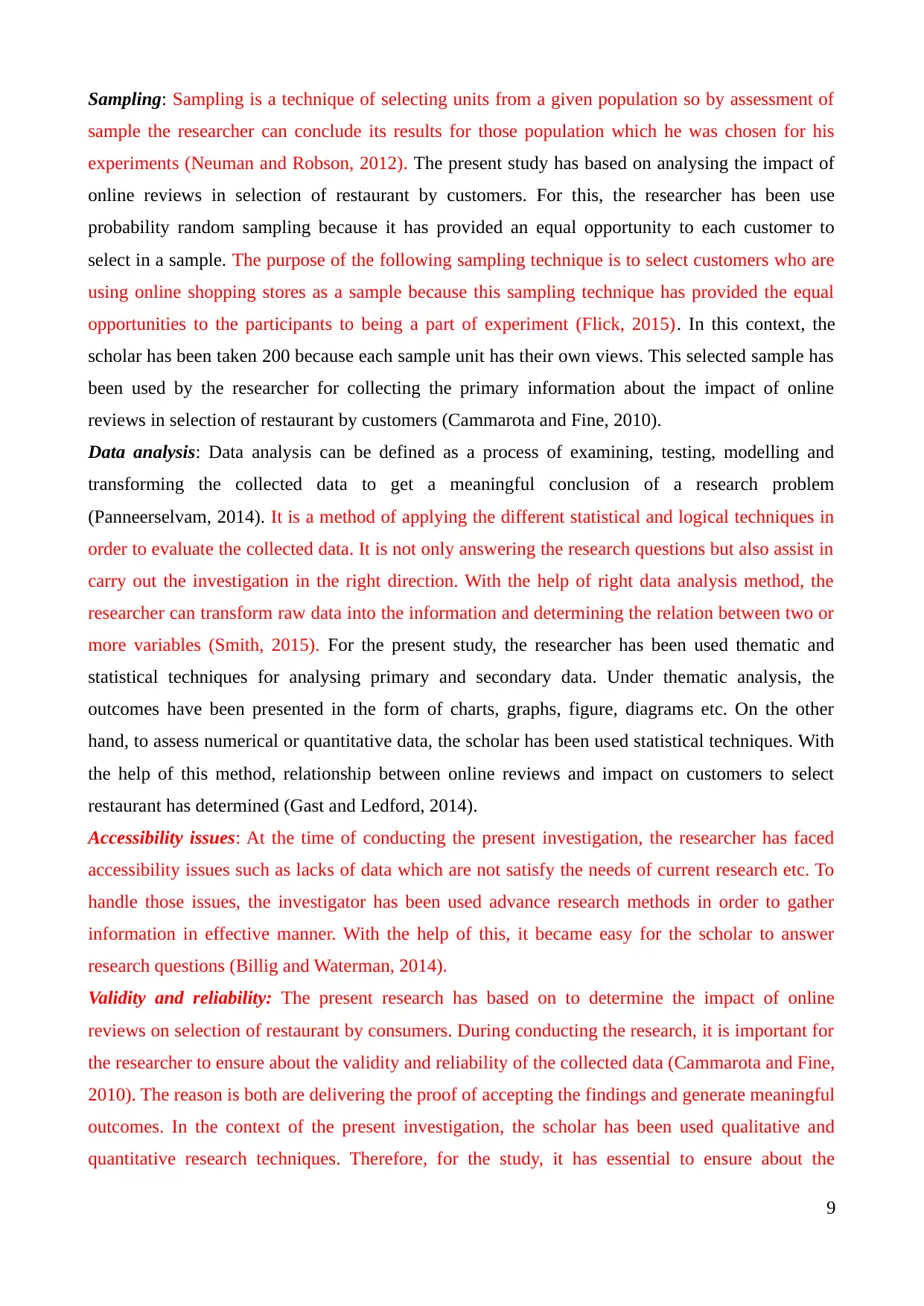
Sampling: Sampling is a technique of selecting units from a given population so by assessment of
sample the researcher can conclude its results for those population which he was chosen for his
experiments (Neuman and Robson, 2012). The present study has based on analysing the impact of
online reviews in selection of restaurant by customers. For this, the researcher has been use
probability random sampling because it has provided an equal opportunity to each customer to
select in a sample. The purpose of the following sampling technique is to select customers who are
using online shopping stores as a sample because this sampling technique has provided the equal
opportunities to the participants to being a part of experiment (Flick, 2015). In this context, the
scholar has been taken 200 because each sample unit has their own views. This selected sample has
been used by the researcher for collecting the primary information about the impact of online
reviews in selection of restaurant by customers (Cammarota and Fine, 2010).
Data analysis: Data analysis can be defined as a process of examining, testing, modelling and
transforming the collected data to get a meaningful conclusion of a research problem
(Panneerselvam, 2014). It is a method of applying the different statistical and logical techniques in
order to evaluate the collected data. It is not only answering the research questions but also assist in
carry out the investigation in the right direction. With the help of right data analysis method, the
researcher can transform raw data into the information and determining the relation between two or
more variables (Smith, 2015). For the present study, the researcher has been used thematic and
statistical techniques for analysing primary and secondary data. Under thematic analysis, the
outcomes have been presented in the form of charts, graphs, figure, diagrams etc. On the other
hand, to assess numerical or quantitative data, the scholar has been used statistical techniques. With
the help of this method, relationship between online reviews and impact on customers to select
restaurant has determined (Gast and Ledford, 2014).
Accessibility issues: At the time of conducting the present investigation, the researcher has faced
accessibility issues such as lacks of data which are not satisfy the needs of current research etc. To
handle those issues, the investigator has been used advance research methods in order to gather
information in effective manner. With the help of this, it became easy for the scholar to answer
research questions (Billig and Waterman, 2014).
Validity and reliability: The present research has based on to determine the impact of online
reviews on selection of restaurant by consumers. During conducting the research, it is important for
the researcher to ensure about the validity and reliability of the collected data (Cammarota and Fine,
2010). The reason is both are delivering the proof of accepting the findings and generate meaningful
outcomes. In the context of the present investigation, the scholar has been used qualitative and
quantitative research techniques. Therefore, for the study, it has essential to ensure about the
9
sample the researcher can conclude its results for those population which he was chosen for his
experiments (Neuman and Robson, 2012). The present study has based on analysing the impact of
online reviews in selection of restaurant by customers. For this, the researcher has been use
probability random sampling because it has provided an equal opportunity to each customer to
select in a sample. The purpose of the following sampling technique is to select customers who are
using online shopping stores as a sample because this sampling technique has provided the equal
opportunities to the participants to being a part of experiment (Flick, 2015). In this context, the
scholar has been taken 200 because each sample unit has their own views. This selected sample has
been used by the researcher for collecting the primary information about the impact of online
reviews in selection of restaurant by customers (Cammarota and Fine, 2010).
Data analysis: Data analysis can be defined as a process of examining, testing, modelling and
transforming the collected data to get a meaningful conclusion of a research problem
(Panneerselvam, 2014). It is a method of applying the different statistical and logical techniques in
order to evaluate the collected data. It is not only answering the research questions but also assist in
carry out the investigation in the right direction. With the help of right data analysis method, the
researcher can transform raw data into the information and determining the relation between two or
more variables (Smith, 2015). For the present study, the researcher has been used thematic and
statistical techniques for analysing primary and secondary data. Under thematic analysis, the
outcomes have been presented in the form of charts, graphs, figure, diagrams etc. On the other
hand, to assess numerical or quantitative data, the scholar has been used statistical techniques. With
the help of this method, relationship between online reviews and impact on customers to select
restaurant has determined (Gast and Ledford, 2014).
Accessibility issues: At the time of conducting the present investigation, the researcher has faced
accessibility issues such as lacks of data which are not satisfy the needs of current research etc. To
handle those issues, the investigator has been used advance research methods in order to gather
information in effective manner. With the help of this, it became easy for the scholar to answer
research questions (Billig and Waterman, 2014).
Validity and reliability: The present research has based on to determine the impact of online
reviews on selection of restaurant by consumers. During conducting the research, it is important for
the researcher to ensure about the validity and reliability of the collected data (Cammarota and Fine,
2010). The reason is both are delivering the proof of accepting the findings and generate meaningful
outcomes. In the context of the present investigation, the scholar has been used qualitative and
quantitative research techniques. Therefore, for the study, it has essential to ensure about the
9
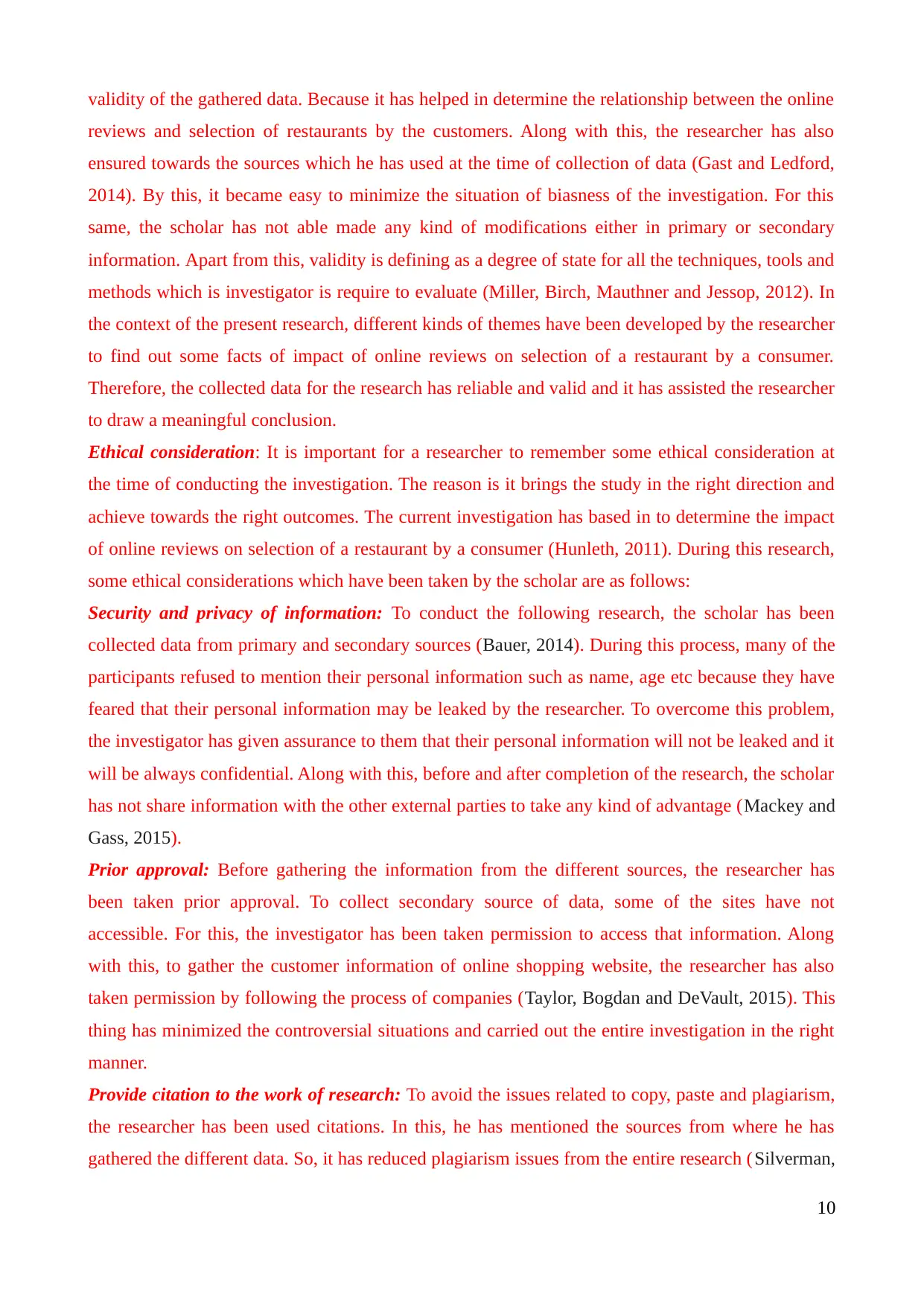
validity of the gathered data. Because it has helped in determine the relationship between the online
reviews and selection of restaurants by the customers. Along with this, the researcher has also
ensured towards the sources which he has used at the time of collection of data (Gast and Ledford,
2014). By this, it became easy to minimize the situation of biasness of the investigation. For this
same, the scholar has not able made any kind of modifications either in primary or secondary
information. Apart from this, validity is defining as a degree of state for all the techniques, tools and
methods which is investigator is require to evaluate (Miller, Birch, Mauthner and Jessop, 2012). In
the context of the present research, different kinds of themes have been developed by the researcher
to find out some facts of impact of online reviews on selection of a restaurant by a consumer.
Therefore, the collected data for the research has reliable and valid and it has assisted the researcher
to draw a meaningful conclusion.
Ethical consideration: It is important for a researcher to remember some ethical consideration at
the time of conducting the investigation. The reason is it brings the study in the right direction and
achieve towards the right outcomes. The current investigation has based in to determine the impact
of online reviews on selection of a restaurant by a consumer (Hunleth, 2011). During this research,
some ethical considerations which have been taken by the scholar are as follows:
Security and privacy of information: To conduct the following research, the scholar has been
collected data from primary and secondary sources (Bauer, 2014). During this process, many of the
participants refused to mention their personal information such as name, age etc because they have
feared that their personal information may be leaked by the researcher. To overcome this problem,
the investigator has given assurance to them that their personal information will not be leaked and it
will be always confidential. Along with this, before and after completion of the research, the scholar
has not share information with the other external parties to take any kind of advantage (Mackey and
Gass, 2015).
Prior approval: Before gathering the information from the different sources, the researcher has
been taken prior approval. To collect secondary source of data, some of the sites have not
accessible. For this, the investigator has been taken permission to access that information. Along
with this, to gather the customer information of online shopping website, the researcher has also
taken permission by following the process of companies (Taylor, Bogdan and DeVault, 2015). This
thing has minimized the controversial situations and carried out the entire investigation in the right
manner.
Provide citation to the work of research: To avoid the issues related to copy, paste and plagiarism,
the researcher has been used citations. In this, he has mentioned the sources from where he has
gathered the different data. So, it has reduced plagiarism issues from the entire research (Silverman,
10
reviews and selection of restaurants by the customers. Along with this, the researcher has also
ensured towards the sources which he has used at the time of collection of data (Gast and Ledford,
2014). By this, it became easy to minimize the situation of biasness of the investigation. For this
same, the scholar has not able made any kind of modifications either in primary or secondary
information. Apart from this, validity is defining as a degree of state for all the techniques, tools and
methods which is investigator is require to evaluate (Miller, Birch, Mauthner and Jessop, 2012). In
the context of the present research, different kinds of themes have been developed by the researcher
to find out some facts of impact of online reviews on selection of a restaurant by a consumer.
Therefore, the collected data for the research has reliable and valid and it has assisted the researcher
to draw a meaningful conclusion.
Ethical consideration: It is important for a researcher to remember some ethical consideration at
the time of conducting the investigation. The reason is it brings the study in the right direction and
achieve towards the right outcomes. The current investigation has based in to determine the impact
of online reviews on selection of a restaurant by a consumer (Hunleth, 2011). During this research,
some ethical considerations which have been taken by the scholar are as follows:
Security and privacy of information: To conduct the following research, the scholar has been
collected data from primary and secondary sources (Bauer, 2014). During this process, many of the
participants refused to mention their personal information such as name, age etc because they have
feared that their personal information may be leaked by the researcher. To overcome this problem,
the investigator has given assurance to them that their personal information will not be leaked and it
will be always confidential. Along with this, before and after completion of the research, the scholar
has not share information with the other external parties to take any kind of advantage (Mackey and
Gass, 2015).
Prior approval: Before gathering the information from the different sources, the researcher has
been taken prior approval. To collect secondary source of data, some of the sites have not
accessible. For this, the investigator has been taken permission to access that information. Along
with this, to gather the customer information of online shopping website, the researcher has also
taken permission by following the process of companies (Taylor, Bogdan and DeVault, 2015). This
thing has minimized the controversial situations and carried out the entire investigation in the right
manner.
Provide citation to the work of research: To avoid the issues related to copy, paste and plagiarism,
the researcher has been used citations. In this, he has mentioned the sources from where he has
gathered the different data. So, it has reduced plagiarism issues from the entire research (Silverman,
10
Secure Best Marks with AI Grader
Need help grading? Try our AI Grader for instant feedback on your assignments.
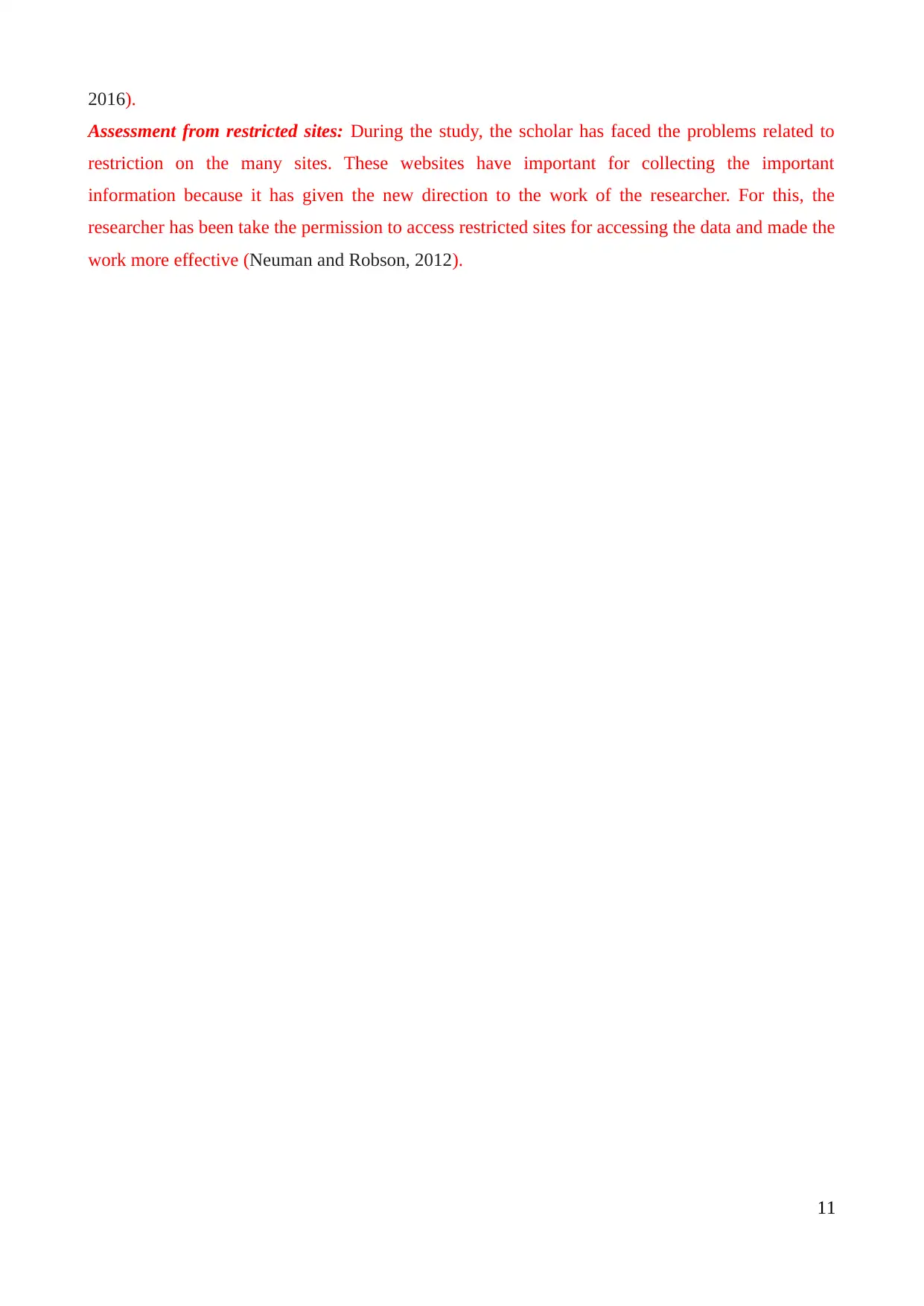
2016).
Assessment from restricted sites: During the study, the scholar has faced the problems related to
restriction on the many sites. These websites have important for collecting the important
information because it has given the new direction to the work of the researcher. For this, the
researcher has been take the permission to access restricted sites for accessing the data and made the
work more effective (Neuman and Robson, 2012).
11
Assessment from restricted sites: During the study, the scholar has faced the problems related to
restriction on the many sites. These websites have important for collecting the important
information because it has given the new direction to the work of the researcher. For this, the
researcher has been take the permission to access restricted sites for accessing the data and made the
work more effective (Neuman and Robson, 2012).
11
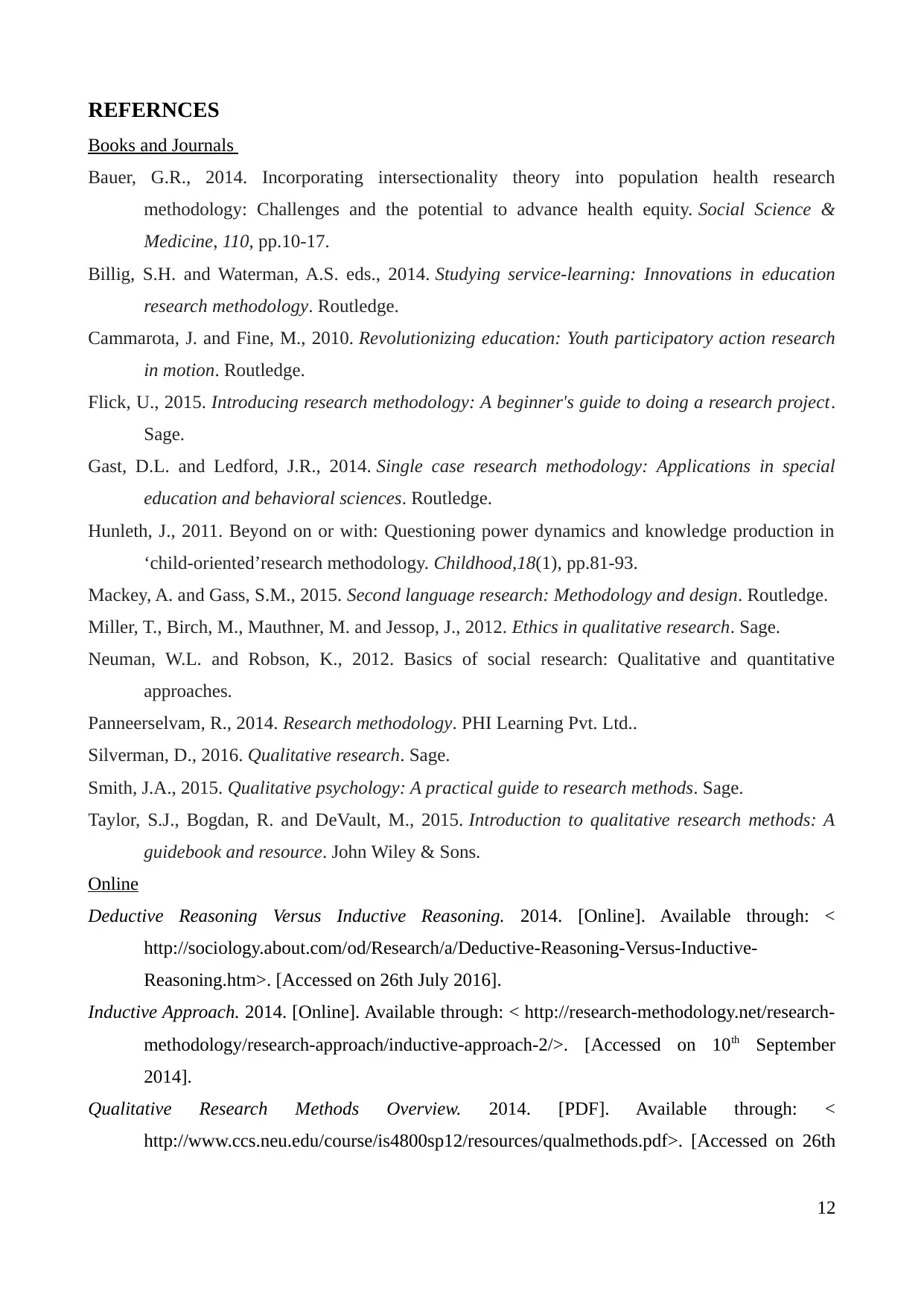
REFERNCES
Books and Journals
Bauer, G.R., 2014. Incorporating intersectionality theory into population health research
methodology: Challenges and the potential to advance health equity. Social Science &
Medicine, 110, pp.10-17.
Billig, S.H. and Waterman, A.S. eds., 2014. Studying service-learning: Innovations in education
research methodology. Routledge.
Cammarota, J. and Fine, M., 2010. Revolutionizing education: Youth participatory action research
in motion. Routledge.
Flick, U., 2015. Introducing research methodology: A beginner's guide to doing a research project.
Sage.
Gast, D.L. and Ledford, J.R., 2014. Single case research methodology: Applications in special
education and behavioral sciences. Routledge.
Hunleth, J., 2011. Beyond on or with: Questioning power dynamics and knowledge production in
‘child-oriented’research methodology. Childhood,18(1), pp.81-93.
Mackey, A. and Gass, S.M., 2015. Second language research: Methodology and design. Routledge.
Miller, T., Birch, M., Mauthner, M. and Jessop, J., 2012. Ethics in qualitative research. Sage.
Neuman, W.L. and Robson, K., 2012. Basics of social research: Qualitative and quantitative
approaches.
Panneerselvam, R., 2014. Research methodology. PHI Learning Pvt. Ltd..
Silverman, D., 2016. Qualitative research. Sage.
Smith, J.A., 2015. Qualitative psychology: A practical guide to research methods. Sage.
Taylor, S.J., Bogdan, R. and DeVault, M., 2015. Introduction to qualitative research methods: A
guidebook and resource. John Wiley & Sons.
Online
Deductive Reasoning Versus Inductive Reasoning. 2014. [Online]. Available through: <
http://sociology.about.com/od/Research/a/Deductive-Reasoning-Versus-Inductive-
Reasoning.htm>. [Accessed on 26th July 2016].
Inductive Approach. 2014. [Online]. Available through: < http://research-methodology.net/research-
methodology/research-approach/inductive-approach-2/>. [Accessed on 10th September
2014].
Qualitative Research Methods Overview. 2014. [PDF]. Available through: <
http://www.ccs.neu.edu/course/is4800sp12/resources/qualmethods.pdf>. [Accessed on 26th
12
Books and Journals
Bauer, G.R., 2014. Incorporating intersectionality theory into population health research
methodology: Challenges and the potential to advance health equity. Social Science &
Medicine, 110, pp.10-17.
Billig, S.H. and Waterman, A.S. eds., 2014. Studying service-learning: Innovations in education
research methodology. Routledge.
Cammarota, J. and Fine, M., 2010. Revolutionizing education: Youth participatory action research
in motion. Routledge.
Flick, U., 2015. Introducing research methodology: A beginner's guide to doing a research project.
Sage.
Gast, D.L. and Ledford, J.R., 2014. Single case research methodology: Applications in special
education and behavioral sciences. Routledge.
Hunleth, J., 2011. Beyond on or with: Questioning power dynamics and knowledge production in
‘child-oriented’research methodology. Childhood,18(1), pp.81-93.
Mackey, A. and Gass, S.M., 2015. Second language research: Methodology and design. Routledge.
Miller, T., Birch, M., Mauthner, M. and Jessop, J., 2012. Ethics in qualitative research. Sage.
Neuman, W.L. and Robson, K., 2012. Basics of social research: Qualitative and quantitative
approaches.
Panneerselvam, R., 2014. Research methodology. PHI Learning Pvt. Ltd..
Silverman, D., 2016. Qualitative research. Sage.
Smith, J.A., 2015. Qualitative psychology: A practical guide to research methods. Sage.
Taylor, S.J., Bogdan, R. and DeVault, M., 2015. Introduction to qualitative research methods: A
guidebook and resource. John Wiley & Sons.
Online
Deductive Reasoning Versus Inductive Reasoning. 2014. [Online]. Available through: <
http://sociology.about.com/od/Research/a/Deductive-Reasoning-Versus-Inductive-
Reasoning.htm>. [Accessed on 26th July 2016].
Inductive Approach. 2014. [Online]. Available through: < http://research-methodology.net/research-
methodology/research-approach/inductive-approach-2/>. [Accessed on 10th September
2014].
Qualitative Research Methods Overview. 2014. [PDF]. Available through: <
http://www.ccs.neu.edu/course/is4800sp12/resources/qualmethods.pdf>. [Accessed on 26th
12
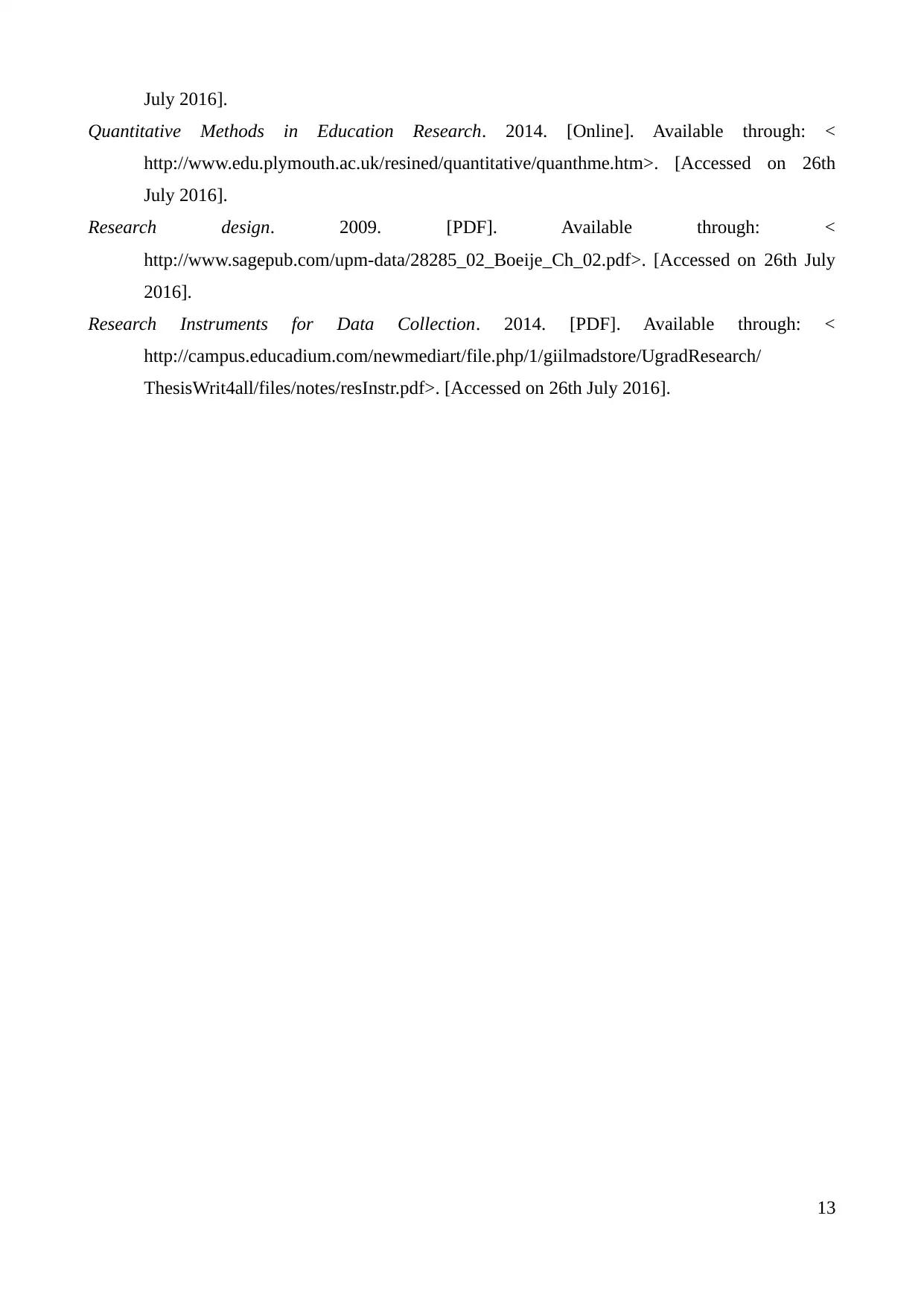
July 2016].
Quantitative Methods in Education Research. 2014. [Online]. Available through: <
http://www.edu.plymouth.ac.uk/resined/quantitative/quanthme.htm>. [Accessed on 26th
July 2016].
Research design. 2009. [PDF]. Available through: <
http://www.sagepub.com/upm-data/28285_02_Boeije_Ch_02.pdf>. [Accessed on 26th July
2016].
Research Instruments for Data Collection. 2014. [PDF]. Available through: <
http://campus.educadium.com/newmediart/file.php/1/giilmadstore/UgradResearch/
ThesisWrit4all/files/notes/resInstr.pdf>. [Accessed on 26th July 2016].
13
Quantitative Methods in Education Research. 2014. [Online]. Available through: <
http://www.edu.plymouth.ac.uk/resined/quantitative/quanthme.htm>. [Accessed on 26th
July 2016].
Research design. 2009. [PDF]. Available through: <
http://www.sagepub.com/upm-data/28285_02_Boeije_Ch_02.pdf>. [Accessed on 26th July
2016].
Research Instruments for Data Collection. 2014. [PDF]. Available through: <
http://campus.educadium.com/newmediart/file.php/1/giilmadstore/UgradResearch/
ThesisWrit4all/files/notes/resInstr.pdf>. [Accessed on 26th July 2016].
13
1 out of 13
Your All-in-One AI-Powered Toolkit for Academic Success.
+13062052269
info@desklib.com
Available 24*7 on WhatsApp / Email
![[object Object]](/_next/static/media/star-bottom.7253800d.svg)
Unlock your academic potential
© 2024 | Zucol Services PVT LTD | All rights reserved.




